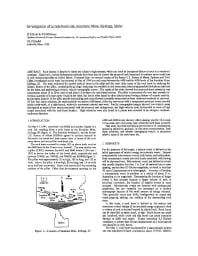Mining Publication: Investigation of a Rock-Burst Site, Sunshine Mine, Kellogg, Idaho
Original creation date: January 1997
Authors: DF Scott, TJ Williams, MJ Friedel
In: Gibowicz SJ, Lasocki S, eds., Proceedings of the 4th International Symposium on Rockbursts and Seismicity in Mines, Balkema, 1997; Jan. 1 :311-315
Rock masses in deep-level mines are subject to high stresses, which can result in unexpected failure of rock into mined-out openings. Historically, various independent methods have been used to discern the causes of rock bursts and to evaluate stress conditions in rock masses susceptible to violent failure. Personnel from two research centers of the former U.S. Bureau of Mines, Spokane and Twin Cities, investigated a rock burst that occurred in May of 1994 in a rock mass between the 4400 and the 4600 levels of the Sunshine Mine, Kellogg, ID. The team evaluated the current state of stress in the pillar and the most likely cause of the rock burst by studying the seismic history of the pillar, examining the geology, analyzing the available in situ stress data, calculating possible fault-lane solutions for the burst, and performing a seismic velocity tomographic survey. The results of the study showed that post-rock-burst seismicity was concentrated about 15 to 30 m west of and about 15 m above the rock-burst location. The pillar is composed of a very hard sericitic-to-vitreous quartzite of a type rarely found in the mine, but that is often found in other district mines having a history of seismic activity. In situ stress analysis of the pillar and the surrounding rock mass showed a probable stress rotation from northwest-southeast to east-west. Of four fault plane solutions, the most probable was either a left-lateral, strike-slip movement with a compressive principal stress oriented nearly north-south, or a right-lateral, strike-slip movement oriented east-west. Finally, tomographic images showed low-velocity areas (interpreted as areas of low stress) associated with the crosscuts and haulageways, and high-velocity areas (interpreted as areas of high stress) associated with the rock-burst location. High velocities were also found in a planar area oriented in an elongate northeast-southwest direction.

In: Gibowicz SJ, Lasocki S, eds., Proceedings of the 4th International Symposium on Rockbursts and Seismicity in Mines, Balkema, 1997; Jan. 1 :311-315
- 60 Years of Rockbursting in the Coeur D'Alene District of Northern Idaho, USA: Lessons Learned and Remaining Issues
- Behavior of a Coal Pillar Prone to Burst in the Southern Appalachian Basin of the United States
- Coal Bumps and Odd Dynamic Phenomena - A Numerical Investigation
- Coal Mine Seismicity and Bumps: Historical Case Studies and Current Field Activity
- Differential Wall Rock Movements Associated with Rock Bursts, Lucky Friday Mine, Coeur d'Alene Mining District, Idaho, USA
- Improvements in Seismic Event Locations in a Deep Western U.S. Coal Mine Using Tomographic Velocity Models and an Evolutionary Search Algorithm
- In Situ Stress at the Lucky Friday Mine (In Four Parts): 2. Analysis of Overcore Measurement From 5300 Level
- Proceedings: New Technology for Ground Control in Multiple-seam Mining
- Rock Bursting and Seismicity During Ramp Development, Lucky Friday Mine, Mullan, Idaho
- Using Fault-Tree Analysis To Focus Mine Safety Research